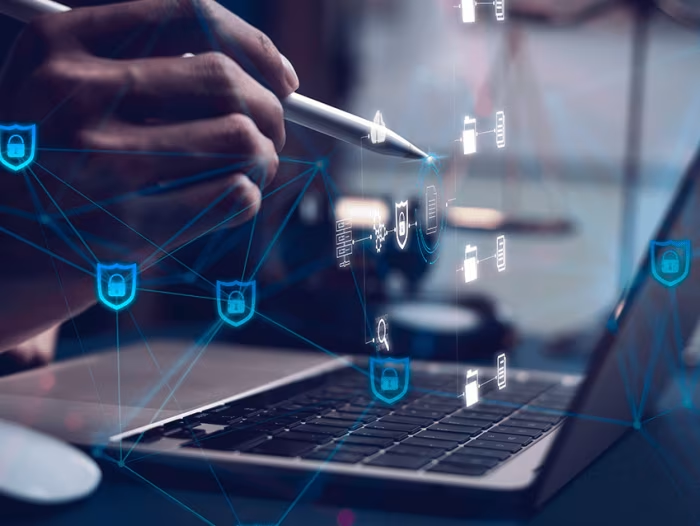Resource / Online Journal
A Comprehensive Introduction to Identity and Access Management (IAM)
Discover how identity and access management can improve your cybersecurity posture. It provides your organization immunity against the growing AI-driven cyberattacks.
Published on Aug 26, 2025

Introduction to Identity and Access Management
Identity and Access Management (IAM) is a crucial framework that helps us govern and secure digital identities. Its main function is to ensure that only authorized users can access the right information, systems, or applications at the right times. It controls user access and thereby safeguards sensitive data from unauthorized breaches.
IAM systems automate identity lifecycle processes, such as provisioning during onboarding and deprovisioning at offboarding. Thus, it creates a single authoritative source for managing user access across complex environments. Automation simplifies administration and strengthens organizational security by minimizing human errors and gaps in permission control.
Importance of Access Management
Access management underpins the security of digital user accounts or assets by rigorously controlling who can enter or operate within systems. Preventing unauthorized access is vital to mitigate risks such as data breaches, intellectual property theft, and regulatory non-compliance.
Role-Based Access Control (RBAC) is a widely adopted strategy where users receive permissions based on their organizational roles, reducing excessive privileges and simplifying access reviews. Along with RBAC, Multi-Factor Authentication (MFA) adds layers of security to protect your organization.
It helps by requiring users to validate identity through multiple credentials to gain access, like passwords coupled with biometrics or tokens. Thus, even if one authentication factor is compromised, there is a shield to protect the data.
Identity Management Fundamentals
IAM is the process of creating, maintaining, and governing digital identities. Identity providers (IdPs) play a pivotal role by securely storing user accounts or identities. It enables authentication across disparate applications and systems.
Identity governance ensures these identities are accurate, updated, and comply with policies and regulations to prevent identity sprawl or orphaned accounts. Technologies like Security Assertion Markup Language (SAML) are also an important upgrade. It also helps in enabling Single Sign-On (SSO), improving user experience while maintaining tight access controls.
Identity Governance and Compliance
Identity governance encompasses policies, processes, and tools to ensure digital identities and access rights comply with regulatory mandates such as GDPR, HIPAA, and industry standards. Proper governance prevents privileges from accumulating beyond necessity, minimizing insider threats and audit failures.
IAM solutions provide continuous access certification and attestation workflows, enabling organizations to verify that users retain only permissions essential to their roles. This consistent oversight mitigates risks of data leakage and enforces accountability. Thus, it becomes an indispensable component in organizational security and compliance strategies.
Access Control and Security
Access control mechanisms define how users interact with digital resources based on verified identity, assigned roles, and contextual attributes. Further, Attribute-Based Access Control (ABAC) evaluates additional factors such as device health, location, time of access, and user behavior to grant or deny access dynamically, which is key for Zero Trust security architectures.
Implementations often rely on Single Sign-On (SSO) combined with Multi-Factor Authentication (MFA) to streamline secure user identity authentication across platforms. These layered controls significantly reduce the attack surface by preventing unauthorized or risky access attempts, bolstering the organization's defense posture.
Access Management Identity Solutions
Modern IAM solutions provide centralized management of user identities and granular access permissions. Examples include platforms like AWS IAM Identity Center, which unify workforce and customer identity management for cloud and on-premises resources.
These solutions automate provisioning, enforce least privilege principles, and support advanced authentication features such as passwordless login and risk-based adaptive access. By integrating comprehensive audit trails and compliance reporting, IAM platforms simplify regulatory adherence while minimizing security risks. Organizations adopting such solutions benefit from operational efficiency, scalability, and improved user experience.
Digital Identities and Authentication
Digital identities are the electronic representations of individuals, devices, or organizations interacting in digital ecosystems. Authentication is the process of verifying these identities.
Traditionally, authentication was done via passwords, but is increasingly enhanced with biometrics, hardware tokens, or passkeys. Robust authentication ensures that only legitimate users can access systems, mitigating risks of credential theft and impersonation.
The evolution toward passwordless methods enhances both security and usability by eliminating weak or reused passwords. These progressive authentication methods are critical as organizations expand digital touchpoints across cloud, mobile, and IoT environments.
Conclusion
Identity and Access Management is one of the foundational factors to secure your organization's modern digital space. It combines user access lifecycle, robust access controls, compliance governance, and progressive authentication.
IAM frameworks protect sensitive data and digital infrastructure or resources from unauthorized access. As threats evolve with AI, AI-driven risk detection, Zero Trust architectures, and decentralized identity is essential to maintaining resilient digital identity security.
Recommended articles


Best IAM Solutions Provider: An In-Depth Exploration of Top Identity and Access Management Services
Take Your Identity Strategy
to the Next Level
Strengthen your organization's digital identity for a secure and worry-free tomorrow. Kickstart the journey with a complimentary consultation to explore personalized solutions.